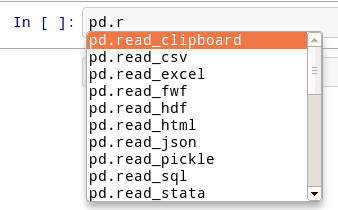Notebook on nbviewer (original) (raw)
- pandas-cookbook
- cookbook Notebook
A quick tour of IPython Notebook¶
This tour will work a little better in interactive mode, so it'll be better if you get IPython notebook installed and running. You can start it from a terminal by running
ipython notebook --pylab inline
The --pylab inline is for plotting graphs
First, we need to explain how to run cells. Try to run the cell below!
In [ ]:
import pandas as pd
print "Hi! This is a cell. Press the ▶ button above to run it"
You can also run a cell with Ctrl+Enter or Shift+Enter. Experiment a bit with that.
One of the most useful things about IPython notebook is its tab completion.
Try this: click just after read_csv( in the cell below and press tab 4 times, slowly
After the first time, you should see this:

After the second time:

After the fourth time, a big help box should pop up at the bottom of the screen, with the full documentation for the read_csv function:

I find this amazingly useful. I think of this as "the more confused I am, the more times I should press tab". Nothing bad will happen if you press tab 12 times.
Okay, let's try tab completion for function names!
You should see this:

Writing code¶
Writing code in the notebook is pretty normal.
In [1]:
def print_10_nums(): for i in range(10): print i,
Saving¶
As of the latest stable version, the notebook autosaves. You should use the latest stable version. Really.
Magic functions¶
IPython has all kinds of magic functions. Here's an example of comparing sum() with a list comprehension to a generator comprehension using the %time magic.
In [3]:
%time sum([x for x in range(100000)])
CPU times: user 24 ms, sys: 4 ms, total: 28 ms Wall time: 27.4 ms
In [4]:
%time sum(x for x in range(100000))
CPU times: user 8 ms, sys: 0 ns, total: 8 ms Wall time: 8.11 ms
The magics I use most are %time and %prun for profiling. You can run %magic to get a list of all of them, and %quickref for a reference sheet.
You can also do nutty things like run Perl code in the notebook with cell magics. This is especially cool for things like Cython code, where you can try out Cython really fast with the %%cython magic (you'll need to install it).
In [6]:
%%perl
$_ = "whoa, python!"; s/python/perl/; print